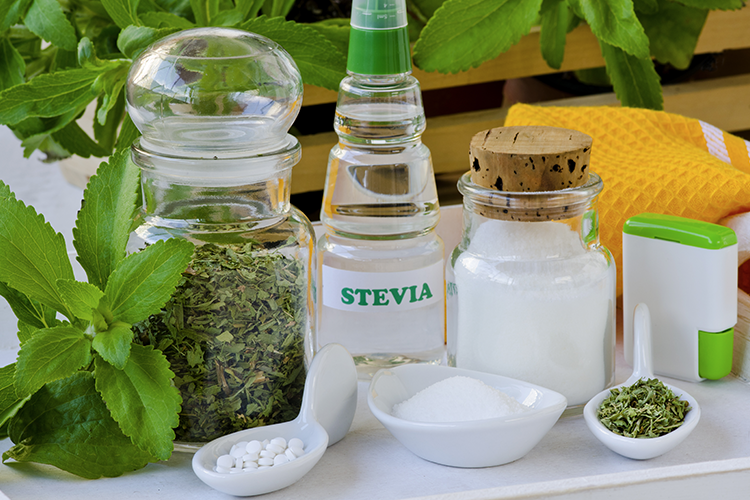Blog
Can sugar substitutes trick us to want more?
Sweeteners are insanely sweet. Anywhere from 180 – 13,000 times sweeter than sugar!1
So sweet, it is thought that the taste receptors over time will be accustomed to such intensity. As a result, finding sweetness in fruit will be difficult, and non-sweet, bitter, more complex tasting foods will become downright intolerable (sorry, broccoli).
Which means eating less variety of nutrient dense foods and flavours, in favour of a less nutritious monotony of sweet. This will not make for a happy mind or body.
We have mentioned using sweeteners may be okay in the short term whilst reducing high levels of sugar in the diet. However, the overall aim is to reduce the amount of sweet stuff consumed altogether, be it table sugar, agave syrup, or a hyper-intense aspartame, as even having the artificial sweeteners can keep the sweet cravings alive.
Health concerns
Artificial sweeteners that are considered safe for consumption in Australia include acesulphame-K, advantame, alitame, aspartame, cyclamate, neotame, saccharin, and sucralose.2
There is concern that artificial sweeteners may actually encourage us to eat more, which is at odds with the purported benefits in weight loss.3-4
You see, when we taste something sweet, the body prepares itself to receive and utilise the sugars coming its way through the digestive track.
However, artificial sweeteners are not sugar and will not supply the expected glucose anticipated.
Therefore, we may react with increased hunger signals for more sweet stuff in search of the sugar that misleadingly the body believed was on its way.
And it is hypothesised that when consuming, say, a diet Coke, we may feel better about eating more sugary junk food later.
Aspartame may even induce glucose intolerance and weight gain, by inhibiting an enzyme that acts to protect us against these.5
Even though research is in early days, there is concern persistent high consumption may increase the risk of heart disease6-7 and certain cancers, and impact the health of your intestinal microbiome (and when that is out of whack, it can lead to all kinds of health issues).
Want the good news?
It is good to remember that naturally occurring sugar packaged in real food like fruit is delivered alongside other nutrients like fibre, vitamins and minerals that are designed to work together to support health.
Our palates are highly adaptable. Increasing sensitivity to sweetness (and therefore tolerating less) can happen in as little as two weeks.
A 2014 study of 20 people removed all added sugar and artificial sweeteners from their diet. Within the two-week trial it was found:
- For 95% of participants, sweet foods and drinks tasted sweeter or too sweet, and moving forward they would use less or no sugar
- For 75%, other foods tasted sweeter
- For 86.6%, the sugar or sweet cravings stopped craving after 6 days. 1
So, give a two-week no-added sugar or artificial sweetener trial a go! You may just find that an apple or banana are sweet enough 😉
By Angela Johnson (BHSc. Nut. Med.)
References:
- Bartolotto, C 2015, ‘Does Consuming Sugar and Artificial Sweeteners Change Taste Preferences?’, The Permanente Journal, vol. 19, no. 3, pp. 81-84.
- FSANZ 2017, Intense sweeteners, viewed 24 January 2017, <http://www.foodstandards.gov.au/consumer/additives/intensesweetener/Pages/default.aspx>
- Cantley, LC 2013, ‘Cancer, metabolism, fructose, artificial sweeteners, and going cold turkey on sugar’, BMC Biology, vol. 11, no. 1, pp. 1-4.
- Hill, SE, Prokosch, ML, Morin, A, & Rodeheffer, CD 2014, ‘The effect of non-caloric sweeteners on cognition, choice, and post-consumption satisfaction’, Appetite, vol. 83, pp. 82-88.
- Gul, A et. al 2016, ‘Inhibition of the gut enzyme intestinal alkaline phosphatase may explain how aspartame promotes glucose intolerance and obesity in mice’, Applied Physiology, Nutrition, and Metabolism, 42, no. 1, pp. 77-83.
- Swithers, S 2015, ‘Not so Sweet Revenge: Unanticipated Consequences of High-Intensity Sweeteners’, Behavior Analyst, vol. 38, no. 1, pp. 1-17.
- Vyas, A, Rubenstein, L, Robinson, J, Seguin, RA, Vitolins, MZ, Kazlauskaite, R, Shikany, JM, Johnson, KC, Snetselaar, L, & Wallace, R 2015, ‘Diet drink consumption and the risk of cardiovascular events: a report from the Women’s Health Initiative’, Journal Of General Internal Medicine, vol. 30, no. 4, pp. 462-468.












